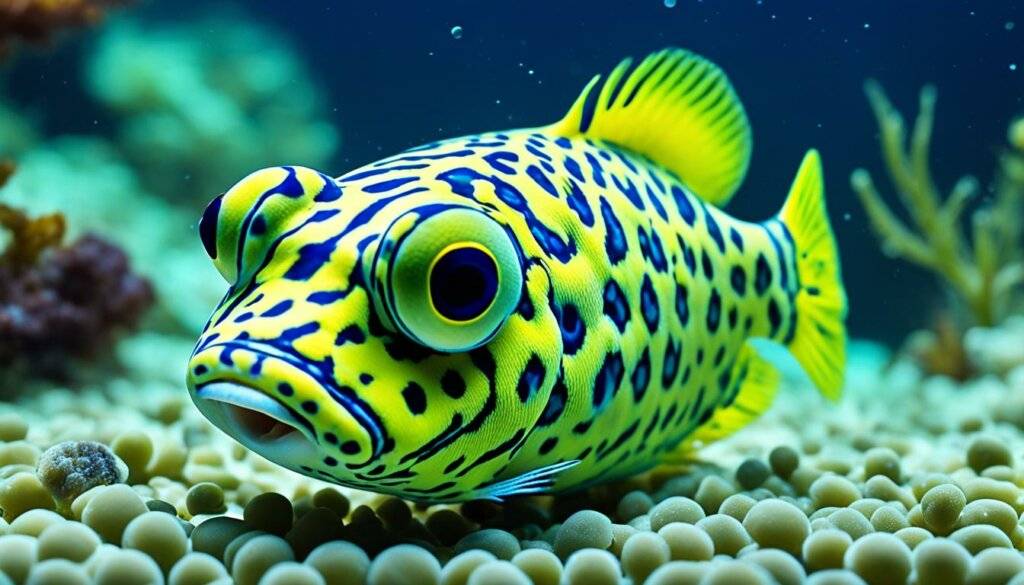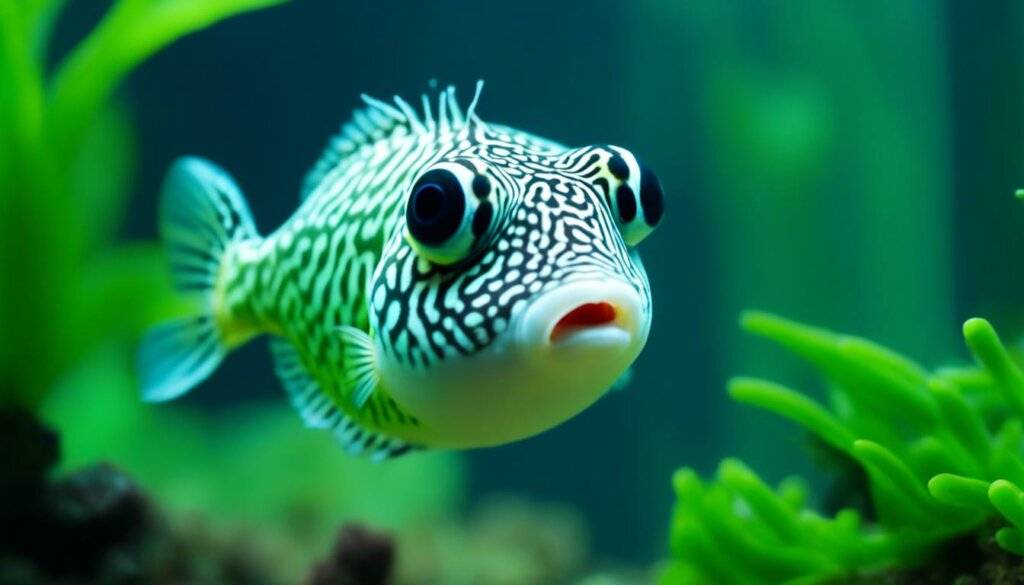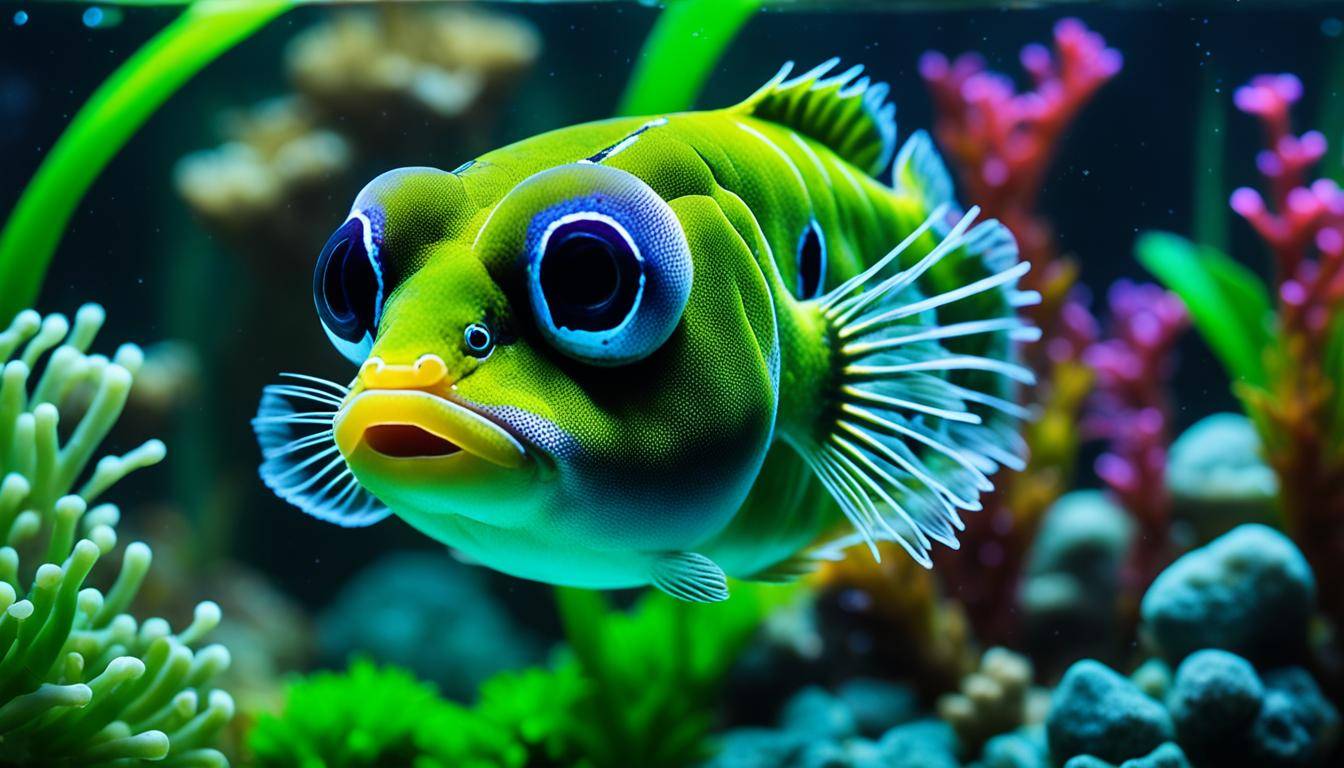Imagine having a tiny underwater world where vibrant colors and fascinating life thrive. Such a nano aquarium brings joy and peace to any room. It is a sight to behold.
What if you could make your miniature world more exciting? The pea puffer is the world’s smallest pufferfish with a big personality.
Meet Finley, a proud nano aquarium owner. He wanted to add something unique to his small underwater kingdom. After careful research, he chose pea puffers for their vigor and dazzling look. These tiny fish quickly became the stars of his aquarium.
Finley was mesmerized by their tiny yet vigorous actions. Their movements around the decorations drew his attention. It was like watching an exciting show every day.
These puffers, with their stunning colors and lively eyes, caught everyone’s interest. Visitors were captivated by their bold personalities. Soon, the pea puffers were the main topic among friends and family.
Pea puffers are perfect for those wanting to enhance their nano aquarium. Their small size and lively nature make them ideal. They bring color and life into a small, watery home.
But there’s a lot to learn about keeping pea puffers. We’ll talk about the right tank setup, what to feed them, and their fellow fish friends. By the end, you’ll know how to properly care for these fascinating fish. You’ll be ready to enjoy their lively presence in your nano aquarium.
Tank Setup and Maintenance for Pea Puffers
To keep your pea puffers healthy, their tank setup and maintenance are key. Here’s what you need to know:
1. Water Parameters
Pea puffers need water that’s 74 to 82°F (23-28°C) and a pH of 6.5 to 8.4. Make sure the water is not too hard or too soft. Good water conditions are vital for their health.
2. Hiding Spots
Being active, pea puffers love having places to hide. Use caves, rocks, and live plants to create hiding spots. This prevents stress and fights among them.
3. Clean and Well-Maintained Water
Pea puffers dislike dirty water. Keep it clean by changing the water often. Test the water for ammonia and other bad substances. Always use a water conditioner to keep the water safe for your fish.
4. Filtration System
A good filter system is a must for a pea puffer tank. It cleans the water from leftover food and waste. Choose the right filter size for your tank and clean it regularly.
5. Lighting
Pea puffers don’t need special lights. But, give them light for about 8-10 hours a day. Adjust the light if your puffers seem stressed.
6. Tank Size
Pea puffers need room to swim and claim their space. A single puffer needs a 5-gallon tank. For more than one, go with a 10-gallon or bigger tank.
“Providing a suitable tank setup and properly maintaining the water conditions is crucial for the health and well-being of your pea puffers.”
Feeding Pea Puffers
Pea puffers are not like other fish; they eat meat. Keeping them healthy means feeding them well.
These small, but lively, fish like their food to move. A mix of live and frozen items works best for them. Some snacks they love are:
- Bloodworms – A top pick, full of good stuff for pea puffers. They offer lots of protein.
- Brine shrimp – These small shrimp are another good choice, full of nutrition. They can be live or frozen.
- Small pest snails – Since pea puffers naturally eat snails, adding some to their menu is a good move.
- White worms – Tiny, whitish, and packed with protein, they make a nice treat for pea puffers.
Variety is key when feeding your pea puffers. Mixing up their menu will keep them in good shape. It stops them from lacking any important nutrients, too.
Teaching some pea puffers to eat dry food is possible. Yet, most do better with live and frozen bites. Such foods keep them acting and feeding like they would in nature.
Feeding Tips:
1. Offer a mix of live and frozen foods to provide a varied diet.
2. Watch their portion sizes. Overfeeding can harm them.
3. Clean up uneaten food fast to keep the water clean.
4. Keep an eye on how much they eat and tweak their diet as necessary.
Seeds of doubt, pea puffers being finicky eaters are not. It just takes time to find what they love. Learning by observation helps you master their menu.

-
Save
Feeding Schedule
| Food | Frequency |
|---|---|
| Bloodworms | Daily |
| Brine shrimp | 2-3 times per week |
| Small pest snails | Weekly |
| White worms | Occasionally |
Tank Mates for Pea Puffers
Pea puffers are known for their spunky behavior, often seen as aggressive. Yet, some fish keepers have found suitable friends for them. Choosing the right friends is key to a chill tank life for your puffers.
Looking to add friends? Go for calm, bottom-dwellers that get along with puffers. Kuhli loaches and pygmy corydoras fit the bill. They’re peaceful and make great community partners for your puffers.
Kuhli loaches look like eels and love the bottom of the tank. They not only look cool but also make your aquarium a bustling place. Meanwhile, pygmy corydoras are small, friendly catfish that keep things fun. They make a nice, peaceful addition to your tank.
Watch how they all get along. Puffers might not like fish with long fins. Keeping an eye on them helps you keep the peace. It lets you see if everyone’s happy and safe together.
Things to Consider When Choosing Tank Mates:
- Size: Pick friends that are about the same size to avoid fights over size.
- Temperament: Choose fish that don’t pick fights to match your puffers’ style.
- Water Parameters: Make sure everyone’s needs in the water are alike for a happy shared home.
- Space: Enough hiding spots and space for all prevents quarrels over territory.
Each fish has its own personality. Compatibility takes research. Knowing about your options ensures all fish live well together.
Unique Characteristics of Pea Puffers
Pea puffers are truly fascinating creatures. They’re smart and have interesting behaviors. These traits make them special among aquarium fish. Let’s look at what makes them so unique.
Playful and Inquisitive Nature
Pea puffers are both playful and curious. This makes them fun to observe in your tank. They like to check out their home, get into small places, and interact with decorations. Their eyes are always looking for something new, which keeps your tank interesting.
Defensive Inflation
One cool thing pea puffers can do is puff up when threatened. They can fill up with water or air quickly. This makes them bigger and harder to eat. It’s not just a safety move; it’s also a warning to stay away.
Tetrodotoxin Defense
Pea puffers have a strong chemical weapon too. They possess a dangerous toxin called tetrodotoxin. This toxin is in different parts of their body and can harm anything that tries to eat them. It’s like nature’s warning sign for predators.
If pea puffers puff up, it means they’re really scared. So, it’s crucial to keep their environment calm and clean. This will help prevent them from using this extreme defense tactic.
| Behavior | Defense Mechanism |
|---|---|
| Playful and inquisitive | Inflation with water or air to deter predators |
| – | Presence of tetrodotoxin as a chemical deterrent |

-
Save
Pea puffers are unique because of their behaviors and defenses. Their cleverness, curiosity, and self-protection tactics make them a great choice for fish lovers. They offer non-stop fun and interest.
Care Tips for Pea Puffers
Making sure your pea puffers are happy and healthy is key. They need the right care and attention. Using these tips, you can make a great home for your small fish friends.
Tank Requirements
Your pea puffers will do well in a fully set-up aquarium. For one puffer, a 5-gallon tank is needed. If you have three, a 10-gallon tank is better. This gives them enough room to swim and check out their surroundings.
Creating a cozy place for your pea puffers is crucial. Add lots of hiding places like caves, rocks, and plants. This makes them feel safe and at home.
Tank Maintenance
Keeping the tank clean is a must for your pea puffers’ health. Always do regular water changes. This keeps the water fresh and safe by getting rid of waste and toxins.
Check the water’s temperature, pH, and ammonia levels often. Make sure they are right for your pea puffers. Big changes in the water can stress them out or make them sick.
Nutrition and Feeding
Pea puffers love meat and need a special diet. Give them a mix of live and frozen foods. Good choices are bloodworms, brine shrimp, snails, and white worms. This mixes things up and keeps them healthy.
These fish can be choosy about food. Try different foods to see what they like. A varied diet keeps them in top shape and looking their best.
Behavior and Observation
Watching your pea puffers can tell you a lot. Look for any odd behavior or signs they’re not well. Things like being slow, not eating, or swimming oddly can mean they’re stressed.
Keeping their environment calm is very important. Don’t put pea puffers with aggressive fish. It could harm them or make them very stress.
Popular Varieties of Puffer Fish for Aquariums
Pea puffers are just one kind of puffer for your tank. If you want more variety, check out these top puffer fish:
- Amazon or South American Puffer: Amazon puffers are loved for their bright colors and patterns. They need a big tank and a diet of live and frozen food.
- Spotted Congo Puffer: These puffers have beautiful spots and are fun to watch. They live best in a big tank with lots of places to hide.
- Arrowhead or Pig-Face Puffer: Arrowhead puffers have a unique shape and a cute face. They live in brackish water and eat both meat and plants.
- Hairy Puffer: Hairy puffers have spiky growths on their bodies. They like a clean tank with plenty of hiding spots.
- Dragon or Humpback Puffer: Dragon puffers look like dragons and need a big tank. They like clean water and food like seafood.
- Figure Eight or Eyespot Puffer: Figure Eight puffers have an eyespot pattern. They live in brackish water and go well with other brackish fish.
Each puffer has special needs, so research their care. Adding them can make your tank very interesting and beautiful.
Here’s an image of some of these popular puffer fish species:
Conclusion
Pea puffers are small but intriguing fish that can liven up your tiny tank. They are known for being territorial and fun to watch. Their unique qualities make them a favorite for those into fish-keeping. But, it’s critical to take good care of them and build the right home.
When you set up your tank, feed them properly, and find good companions, you have to think carefully. With the right steps, you make a perfect space for these little, energetic fish. Their presence can make your nano tank a vibrant one.
Keeping the tank clean, feeding them various foods, and choosing the right companions are key to their well-being. Proper care means your pea puffers will not only stay healthy. They will also keep you entertained with their interesting habits. So, dive in and make an amazing, lively nano tank. Let the pea puffers be the main attraction!
